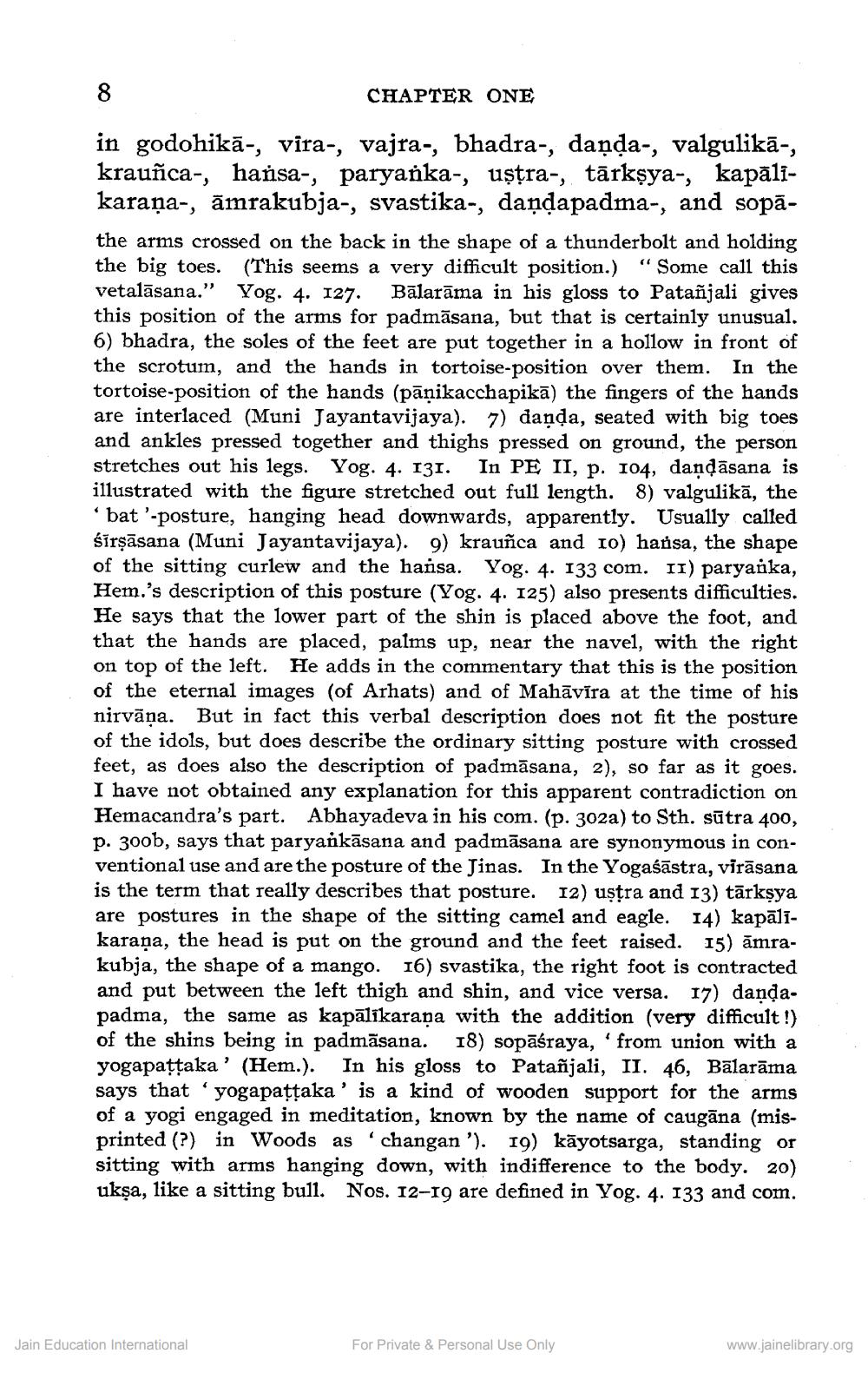________________
∞
CHAPTER ONE
in godohikā-, vīra-, vajra-, bhadra-, daṇḍa-, valgulikā-, krauñca-, hansa-, paryanka-, uṣṭra-, tārkṣya-, kapālikaraṇa-, āmrakubja-, svastika-, daṇḍapadma-, and sopāthe arms crossed on the back in the shape of a thunderbolt and holding the big toes. (This seems a very difficult position.) "Some call this vetalāsana." Yog. 4. 127. Bālarāma in his gloss to Patanjali gives this position of the arms for padmasana, but that is certainly unusual. 6) bhadra, the soles of the feet are put together in a hollow in front of the scrotum, and the hands in tortoise-position over them. In the tortoise-position of the hands (pāņikacchapikā) the fingers of the hands are interlaced (Muni Jayantavijaya). 7) daṇḍa, seated with big toes and ankles pressed together and thighs pressed on ground, the person stretches out his legs. Yog. 4. 131. In PE II, p. 104, daṇḍāsana is illustrated with the figure stretched out full length. 8) valgulikā, the 'bat '-posture, hanging head downwards, apparently. Usually called śīrṣāsana (Muni Jayantavijaya). 9) krauñca and 10) hansa, the shape of the sitting curlew and the hansa. Yog. 4. 133 com. II) paryanka, Hem.'s description of this posture (Yog. 4. 125) also presents difficulties. He says that the lower part of the shin is placed above the foot, and that the hands are placed, palms up, near the navel, with the right on top of the left. He adds in the commentary that this is the position of the eternal images (of Arhats) and of Mahāvīra at the time of his nirvāņa. But in fact this verbal description does not fit the posture of the idols, but does describe the ordinary sitting posture with crossed feet, as does also the description of padmasana, 2), so far as it goes. I have not obtained any explanation for this apparent contradiction on Hemacandra's part. Abhayadeva in his com. (p. 302a) to Sth. sutra 400, p. 300b, says that paryankāsana and padmāsana are synonymous in conventional use and are the posture of the Jinas. In the Yogaśāstra, vīrāsana is the term that really describes that posture. 12) ustra and 13) tarkṣya are postures in the shape of the sitting camel and eagle. 14) kapālikaraṇa, the head is put on the ground and the feet raised. 15) amrakubja, the shape of a mango. 16) svastika, the right foot is contracted and put between the left thigh and shin, and vice versa. 17) dandapadma, the same as kapālīkaraṇa with the addition (very difficult!) of the shins being in padmasana. 18) sopāśraya, 'from union with a yogapaṭṭaka' (Hem.). In his gloss to Patanjali, II. 46, Bālarāma says that 'yogapaṭṭaka' is a kind of wooden support for the arms of a yogi engaged in meditation, known by the name of caugāna (misprinted (?) in Woods as changan '). 19) kayotsarga, standing or sitting with arms hanging down, with indifference to the body. 20) ukşa, like a sitting bull. Nos. 12-19 are defined in Yog. 4. 133 and com.
C
Jain Education International
For Private & Personal Use Only
www.jainelibrary.org




